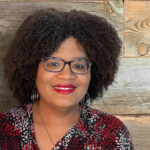Insights is a SmartBrief Education Originals column that features perspectives from noted experts and leaders in education on the hot-button issues affecting schools and districts. All contributors are selected by the SmartBrief Education editorial team.

Equity in math education is about much more than changing names to represent more diverse students or putting images of different kinds of people on the page. Representation is an important part of equity, but it must go deeper than just changing the race or gender of people doing math in textbooks, videos and other learning resources. Equity is about diversifying math in ways that help students understand and see themselves as mathematical people.
We must understand what prevents marginalized students from feeling like they can’t be math people. Sometimes that is a lack of representation, but more often it’s also a lack of opportunities to develop a positive math identity. The world is filled with people who describe themselves as non-math people, and there are a lot of stereotypes about who can and can’t do math.
Part of making math equitable is helping everyone see it as something they can do. As a curriculum designer and a leader on a co-design team that works with students, families, teachers and administrators to make math accessible to everyone, here’s how I help students build their own positive math identities.
Answering some foundational questions
Central to helping students build their own positive math identity is helping them understand the answers to a few questions.
Who can do math?
The answer is that everyone can do math. The oldest math artifact is from an ancient African culture and is one example that shows that people from all backgrounds have been using math pretty much as long as there have been people. Math is a thing that humans do. Everyone can do math.
What does math look like, and how do I make sense of it?
Math is most commonly thought of as computation, and students who struggle with computation feel like that is evidence that they can’t do math. But math is more than computation. It’s a way that humans experience the world. A student who is really good at music or drumming or rapping is keeping time with fractions, even if they don’t describe it in those words or understand it in those terms. Students who are great at video games are performing spatial thinking that is also mathematical.
Helping students understand that math is not just a subject they study in school — but something they use naturally to interact with and relate to the world — makes it more accessible and helps them understand that they and the people around them do math all the time. Students need opportunities to demonstrate a variety of strategies and ways of thinking about math to help connect math in their personal world to math in school.
Who knows math?
If you ask students this question, they will tell you the teacher knows math, and the kid who’s always raising her hand knows math. But they might not say, “I know math.”
Helping them understand that they do, in fact, know math goes back to that question about what math looks like. Sure, it’s the teacher and the students eager to answer every question, but it’s also the athletes calculating angles in football or basketball. It’s also artists subconsciously using the rule of thirds to compose a picture or relying on geometry to give a drawing perspective and depth.
All students are people who know math. Whether they realize it or not, they do math every day. Every day they probably engage in some type of estimation activity, like traveling to school or budgeting time.
Helping students see they already are math people
Answering these fundamental questions is about more than just building up students’ self-esteem as it relates to math. It goes right to the root of how people learn. Learning isn’t transferred from one person to another; it is built within by the learner through their experiences. If the teacher is the person who knows math, it’s something students must get transferred to them from her. If the student is a person who knows math and does math, they are positioned to take ownership of their learning and construct it themselves with the guidance and support of the teacher.
Telling students the answers to these questions won’t suddenly give them a positive math identity to build upon. Students have to be given experiences that allow them to show how they do math, know math and make sense of math. If they have the space to talk about math and share their strategies with each other, they have an opportunity to expand their understanding, build confidence and grow in their knowledge of math.
Changing the names in curriculum materials and adding images of marginalized groups isn’t doing enough. We must create meaningful experiences that change the relationship each student has with math and how they see themselves as a math person.
Building positive math identity in the classroom
Building a positive math identity in the classroom requires giving students agency and the opportunity to build learning in meaningful ways. They need to try things that make sense to them. Sometimes they will be right and sometimes they will be wrong. Being wrong is not bad. It helps students understand that mistakes are part of learning.
Whenever we have an experience, our brains build a schema that helps us predict what will happen when we have similar experiences in the future. When our predictions are correct, that schema gets stronger. When our predictions are incorrect, the schema is weakened, and we look for new strategies to solve the problem.
By allowing students to try and fail and try again with new information, teachers empower them to build their learning by testing and refining their mathematical schemas. It’s inherently relevant to students because their mistakes and their learning are driven by their particular understanding and previous experiences.
Why it’s important for students to talk about math together
Students also need opportunities to hear from one another. Letting a variety of students share their strategies and thinking about math positions them as authors of their learning. It also gives them opportunities to make many different kinds of connections between their thinking and that of their peers. Teacher facilitation of these discussions helps students build learning and recognizes the importance of student thinking in learning math. It also highlights the assets that students bring and helps students understand that they can be powerful contributors to math discussions.
Hearing how others are thinking about a problem can make it more accessible to students who are struggling with where to start. Sometimes it is as simple as asking them to turn to their neighbor and explain why they believe what they do about the problem. This helps students see themselves and their peers, especially peers who look like them, as mathematical resources. The perspective of their peers can spark ideas, discussions and debates that can lead to a better understanding.
Rather than spending a lot of time creating individual lesson plans, creating an equitable classroom is often about choosing strategies and materials that allow students to see themselves as people who do math.
Perhaps the best way for teachers to incorporate these ideas into their practice is to give students lots of opportunities to talk about their thinking. Whether they get an answer right or wrong, holding them accountable by asking them to explain how they got there and where they go from here empowers them and helps them see math as something they personally can do.
One key question that I ask my curriculum design team about what we are building is “What’s the value added?” The value we’re adding most often is in creating activities and experiences designed to build math identity and content understanding so that students say confidently “I am” when asked, “Who is a math person?”
Twana Young, a former classroom teacher, district curriculum specialist and district curriculum director, is vice president of curriculum and instruction at Mind Education, where she leads the overall vision, strategy, and execution for curriculum materials, resources, and professional learning across Mind’s suite of products, ST Math and InsightMath. She also holds a leadership role in Mind’s co-design group, Math Equity in Design, a community of people who have worked with students of color, have been students of color or are teachers of color and who are co-designing culturally relevant math curriculum that connects with all students. She can be reached at [email protected].
Opinions expressed by SmartBrief contributors are their own.
_________________________
Subscribe to SmartBrief’s FREE email ASCD newsletter to see the latest hot topics in education. It’s among SmartBrief’s more than 250 industry-focused newsletters.
